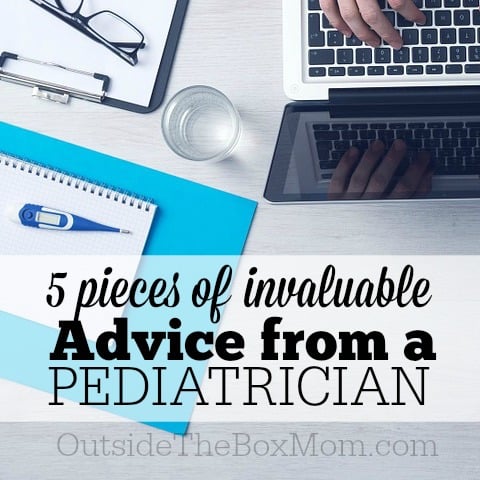Do you wish that you could get answers to your medical questions or demystify common emergencies by a sensible doc with mom know-how?

I’ve posed five common questions to a Doctor, Associate Professor in Emergency Medicine and Pediatrics, and (most importantly) the mom of two active boys. We’ll learn more about this mystery doctor and her latest project later in this post.
1. What’s the difference between a cold and the flu?
A “cold” is a lay person’s term for an Upper Respiratory Infection. This usually describes a constellation of symptoms including cough, congestion, fever, and runny nose. These symptoms can be caused by over 100 different viruses.
The word “flu” gets used in many ways. In the purest form, it denotes an infection by the Influenza virus causing fever, chills, body aches, headache and, here is the confusing part, includes upper respiratory symptoms also. However, the word “flu” is also used for other illnesses such as stomach flu which includes vomiting and diarrhea but actually has nothing to do with Influenza.
Related Posts to Help Keep Your Family Healthy:
- How to Make Simple Homemade Shower Soothers
- How to Have a Fu-Free Season
- The Ultimate Mom’s Guide to Prepare for Winter
- 5 Simple But Effective Ways to Treat Colds in Winter
2. I’d love to know about how much sugar, sodium, and such that young kids should be allowed each day.
The American Heart Association (AHA) limits the sugar intake for children up to 8 years old at 3-4 teaspoons per day. Kids over 8 and teens should be limited to 5 to 8 teaspoons per day.
To put that in perspective, a can of soda alone contains 10 teaspoons of sugar! Read the labels; you may be surprised how much sugar is in things that are marketed to kids such as yogurt, “healthy” cereal, and snack items.
For sodium, the AHA recently reported that 90% of kids in America are eating too much sodium from foods like pizza, sandwiches with meat and cheese and savory snacks like chips. According to the Institute of Medicine, for kids aged 1-3, the recommended sodium intake is 1000 mg; for kids aged 4-8, the intake recommendation is 1200 mg; and for kids 9 and above, 1500 mg is the limit.
Again, reading the labels becomes important. Processed foods are the biggest source of sodium. Eliminating salt when you cook and no added salt at the table will also go a long way to limiting sodium intake.
3. When should I take my son to the doctor or urgent care with a sore throat, cold-, and flu- symptoms?
When a child is sick with an upper respiratory illness or Influenza, they will have decreased activity, decreased appetite, act cranky, and feel miserable.
This is worrisome to parents but expected when they are sick. Most often, these infections are caused by viruses. This means the body has to fight off the infection and there are no medications a doctor can prescribe that will make it go away any faster.
I tell parents to come into the doctor when there are signs that the body is not doing well fighting off infection. Here are some things to look for:
1. Difficulty breathing. When kids are congested, especially when laying down at night, they will breathe loudly. This is normal. Coughing can look painful and can result in vomiting. This is also common.
However, when a child is not congested/not coughing and looks to be struggling to breathe (skin sucks around the ribs with each breath, panting respiratory rate, or wheezing sound from the throat), this needs medical attention.
2. Dehydrated. Poor appetite for food is a normal part of being sick but kids still need to be drinking, albeit it will be less than normal. If the inside of the mouth is dry and the urine output is significantly decreased for age, get checked out by your doctor. Your doctor will decide if IV fluids are necessary.
3. Fever that lasts more than 7 days. Fevers are expected for all upper respiratory infections and most of these illnesses will have about 3-5 days of fever. If the fever is persisting beyond 7 days, there may be a secondary bacterial infection.
For example, the illness starts as a viral upper respiratory illness and becomes a secondary bacterial pneumonia. Although it is possible that viral illnesses can produce prolonged fevers, a physical exam by your doctor looking for other signs of bacterial infection should be sought after a week of fever.
4. Sore throat with no other upper respiratory symptoms in a school-aged kid may represent Strep throat (throat infection caused by Streptococcus). This diagnosis can be made clinically (looking at the throat) and with a throat swab/culture.
Unlike all the other upper respiratory infections or Influenza, this is a bacterial infection that requires antibiotics.
5. Other bacterial infections that start like a viral upper respiratory infection include:
- Peritonsillar abscess. This starts as a sore throat and turns into an abscess near one of the tonsils. Usually seen in older kids or teenagers with acute worsening of sore throat and changes in the voice. The doctor can make the diagnosis by looking at the throat.
- Otitis media (middle ear infection) can result from prolonged nasal congestion with fluid that stays in the middle ear for prolonged periods of time. The child will have quick onset of severe one-sided ear pain and the diagnosis, again, is made by looking at the ear.
- Sinusitis (I hesitantly add this one); there are 4 sets of sinuses and kids only have 2 of them developed at birth and the rest gradually develop over the next 7 years. It is my opinion that his diagnosis should be reserved for weeks of congestion/runny nose in the older child rather than an acute illness.
Related: How to Make Simple Homemade Shower Soothers
4. If my daughter complains that her jaw and ear are hurting but doesn’t have a fever, what should I do? This often happens when she gets a cold in the late fall/early winter.
The jaw and ear share the same nerves so any infection or inflammation in that area will produce the same pain. Most often when associated with an upper respiratory illness, the pain is coming from fluid that is trapped in the middle ear because the tubes that drain the ears are clogged.
Most often, the fluid is not infected and the pain will go away when the congestion resolves. If the ear drum looks red, bulging, and thickened (your doctor would have to look at the ear), then the fluid has become infected and your child has an ear infection.
Alternatively, the pain could be coming from tooth pain (dental cavities), parotid gland (inflammation of the parotid gland from a blocked duct), or swollen lymph nodes of the neck often seen during an upper respiratory illness.
5. What should I do if a child complains that they have an ear ache, but there is no fever and I want to avoid antibiotics?
Most often, you can give simple ear aches 2 days to resolve on their own. There is some literature to support that most ear infections will resolve on their own without antibiotics and without serious complication.
However, if you notice any redness/tenderness behind the ear, one ear is pushed forward compared to the other, or there is drainage coming from the ear canal, then you need to see a doctor.
For simple ear aches, use ibuprofen or acetaminophen for pain. Warm compresses on the external ear may add some relief. If the child is congested, keep the head elevated and treat nasal congestion with a decongestant if the child is over 6 years old.
There are over-the-counter ear pain drops but use these with caution as the bones in the ear can become damaged if the ear drum has perforated (you would only know this after a doctor looked in the ear).
Who is Dr. Andy?
Andrea Thorp, MD is an Associate Professor in Emergency Medicine and Pediatrics. She completed sub-specialty training in pediatric emergency medicine after finishing a residency in pediatrics.
Since completing her fellowship, she has published many research articles and is currently editing a book about women in medicine. She has lectured at various conferences and travelled as far as India to lecture to the medical community, however, teaching the physician-trainees at her local hospital gives her the most excitement.
She is mother of two active boys and attempts to find balance by practicing martial arts and tending her olive groves.
About Paging Dr. Andy
The doctor is in! Paging Dr. Andy is a new series from Awestruck, a network and lifestyle brand for millennial moms, debuting today and featuring ER physician, pediatrician and mom, Dr. Andrea Thorp.
In each episode, Dr. Andy takes viewer’s daily medical questions to the street to demystify common emergencies and use her sensible doc meets mom know-how to give parents peace of mind.
Paging Dr. Andy aims to give parents and alternative to chronically Googling kids’ symptoms, by offering reassurance from an actual medical professional that will help decipher if it’s pink eye or just eye crust, ear infection or just teething.
Episodes of Paging Dr. Andy will post weekly to Awestruck’s channel on the go90, a free new entertainment app available on any iOS or Android device. Once you’re logged into go90, just hit the browse icon and search for “Paging Dr. Andy.”
What’s the best advice you’ve received from your pediatrician?
More Posts to Help Keep Your Kids Healthy:
- 5 Signs Your Child Will Need Braces in the Future
- 10 Tips on How to Improve Eyesight
- How to Sleep Better
- Advice From a Mom & Chef on How to Create Family Memories Around Food
- Advice from a Nutritionist on Getting Picky Eaters to…Eat

